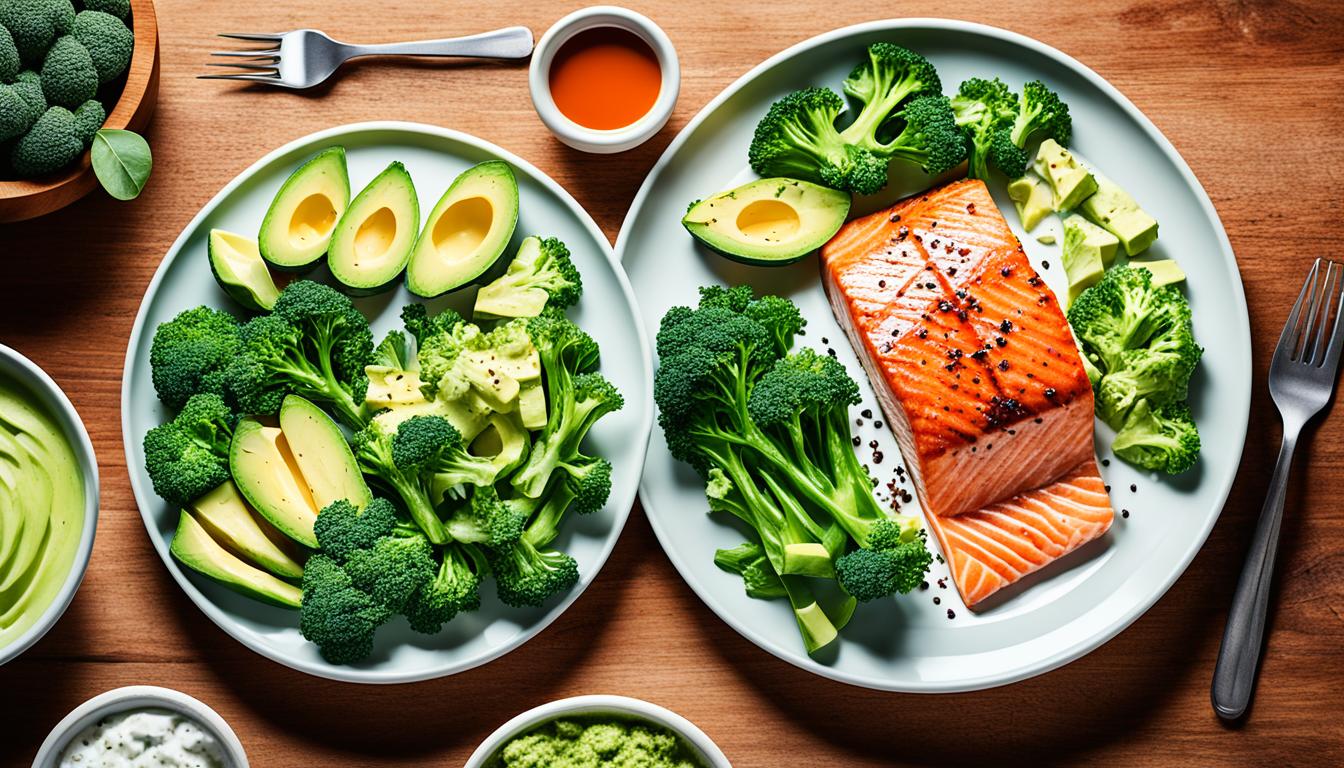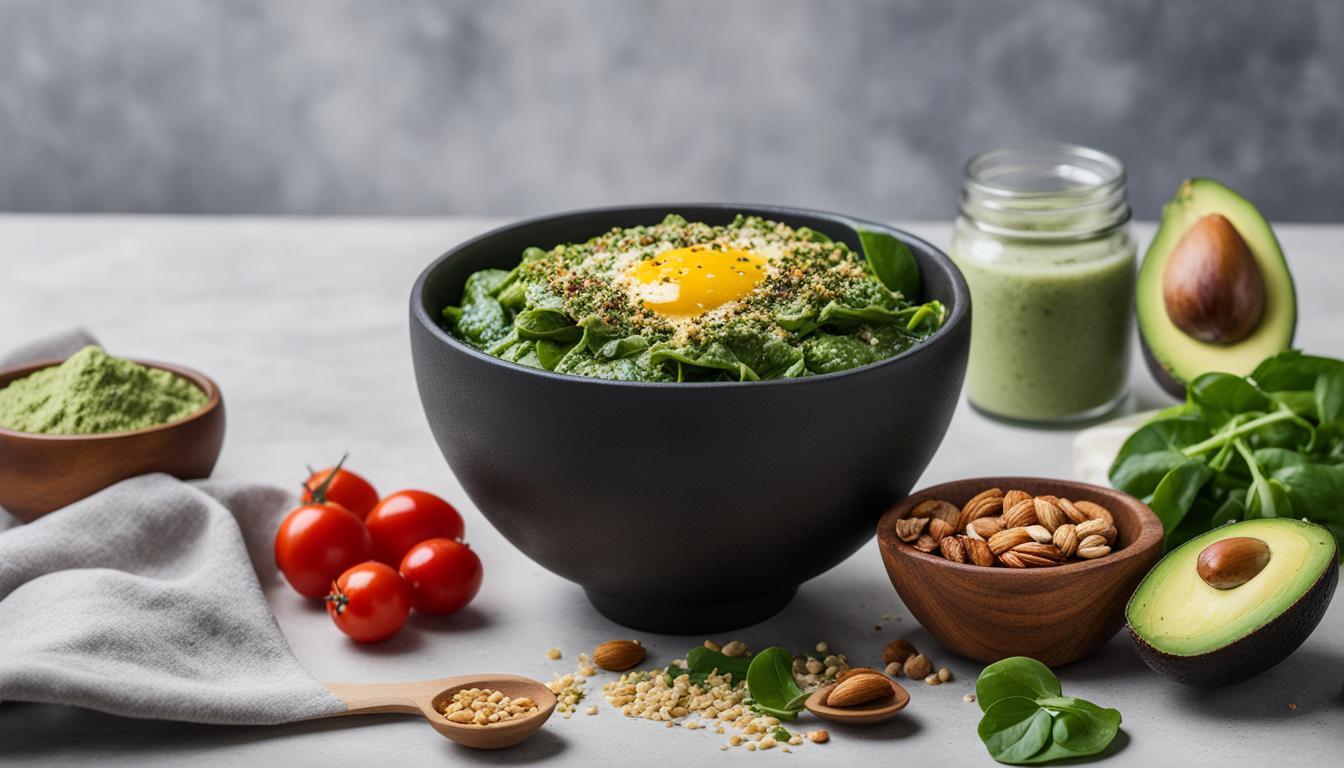Horseradish, with its distinct flavor, is a popular spice used in various dishes. But if you’re following a keto diet, you may be wondering whether horseradish is keto-friendly or not. This article aims to break down the carb content, nutritional value, and health benefits of horseradish on a ketogenic diet, as well as provide low-carb alternatives and meal planning ideas.
Key Takeaways:
- Horseradish can be included in a keto diet, but portion control is crucial due to its carb content.
- It contains 7.99g of net carbs per 100g serving, so careful tracking is necessary to stay within the daily carb limit.
- Horseradish is low in calories and provides dietary fiber, vitamin C, potassium, and other essential nutrients.
- Choosing low-carb alternatives like mustard, wasabi, hot sauces, radishes, or ginger can provide similar flavors without the high carb content.
- Including horseradish in a keto meal plan requires balancing its flavor with its carb content to maintain ketosis.
Is Horseradish Keto-Friendly?
When it comes to following a keto diet, it’s essential to be mindful of the carb content of the foods you consume. Horseradish, with its distinct flavor, may seem like a keto-friendly option, but it’s important to understand its impact on your carb intake.
Horseradish contains approximately 7.99g of net carbs per 100g serving. While it’s not excessively high in carbs, the net carb count can add up quickly, especially if you’re strictly limiting your daily carb intake on a ketogenic diet. To enjoy horseradish on keto, portion control is key to ensure it fits within your daily carb count and doesn’t disrupt ketosis.
Image:
To give you a better understanding of the carb content of horseradish, take a look at the table below:
| Nutrient | Amount per 100g |
|---|---|
| Net Carbs | 7.99g |
| Fiber | 2g |
| Protein | 1.18g |
| Fat | 0.4g |
| Calories | 48 |
By practicing portion control and incorporating horseradish in moderation, you can still enjoy its unique flavor while maintaining ketosis. Remember to keep track of your daily carb intake and balance it with other low-carb foods to stay on track with your keto goals.
Tip: Pairing horseradish with keto-friendly options like grilled meats or low-carb vegetables can enhance your meals without compromising your carb intake.
Keto-Friendly Alternatives to Horseradish
If you’re concerned about the carb content of horseradish or simply want to explore other options, there are keto-friendly alternatives that can provide a similar flavor profile. Consider incorporating the following low-carb options into your keto meals:
- Mustard
- Wasabi
- Hot sauces
- Radishes
- Ginger
These alternatives can add a kick to your dishes and provide variety while keeping your carb intake in check.
Remember, it’s always important to choose options that align with your individual dietary needs and consult with a healthcare professional or registered dietitian for personalized guidance on incorporating horseradish or its alternatives into your keto diet.
Horseradish Nutrition Facts on a Keto Diet
Horseradish is a low-calorie root vegetable that offers a range of essential nutrients. While it can be included in a keto diet, it’s important to consider its macronutrient breakdown and the vitamins and minerals it provides. Let’s explore the nutritional value of horseradish on a keto diet.
Horseradish Macronutrient Breakdown
Horseradish contains a moderate amount of calories, carbohydrates, fats, and proteins. Here is a breakdown of its macronutrient content per 100g serving:
| Nutrient | Amount per 100g |
|---|---|
| Calories | 48 kcal |
| Carbohydrates | 10.51g |
| Fat | 0.83g |
| Protein | 1.18g |
Horseradish is relatively low in calories, making it a suitable choice for those following a keto diet. However, it’s important to keep in mind its carbohydrate content and practice portion control to stay within your daily carb limit.
Vitamins and Minerals in Horseradish on Keto
Horseradish is packed with essential vitamins and minerals that contribute to overall health. Here are some key nutrients found in horseradish:
- Dietary Fiber: Horseradish is a good source of dietary fiber, which aids in digestion and supports a healthy gut.
- Vitamin C: It is rich in vitamin C, an antioxidant that boosts immune function and promotes collagen production.
- Potassium: Horseradish contains potassium, a mineral that helps regulate blood pressure and supports heart health.
- Calcium: It provides calcium, which is essential for strong bones and teeth.
- Other Vitamins and Minerals: Horseradish also contains trace amounts of iron, magnesium, phosphorus, and vitamin B6.
While horseradish offers valuable vitamins and minerals, it’s important to consume it in moderation on a keto diet due to its carb content. Incorporate it into your meals mindfully, taking into account your overall daily carb intake.
Horseradish on a Strict Keto Diet
Incorporating horseradish into a strict keto diet can be a challenge due to its carb content. This flavorful root vegetable contains carbohydrates that can disrupt ketosis if consumed in excessive amounts.
Challenges of including horseradish in keto:
- Carb Control: Staying within the daily carb limit is crucial for maintaining ketosis. Horseradish’s carb content must be carefully tracked and accounted for in meal planning.
- Portion Management: Proper portion control is necessary to avoid exceeding the allotted carb intake. Be mindful of the serving size and adjust accordingly.
Maintaining ketosis with horseradish:
While horseradish can be a flavorful addition to keto meals, it’s important to balance its taste with its carb content to maintain ketosis. This can be achieved by using small amounts as a condiment or flavor enhancer rather than consuming it as a primary ingredient.
To effectively incorporate horseradish into a strict keto diet, consider the following tips:
- Measure and Track: Use a food scale or measuring cups to accurately measure the amount of horseradish to ensure it fits within your daily carb goals.
- Pair with Low-Carb Foods: Combine horseradish with low-carb options like leafy greens, protein, or vegetables to create balanced keto meals.
- Explore Substitutes: If the carb content of horseradish poses a challenge, experiment with keto-friendly alternatives like mustard, wasabi, hot sauces, radishes, or ginger to add similar flavors without compromising ketosis.
Quote: “Balancing the inclusion of horseradish in a strict keto diet requires attention to portion control and mindful tracking of carb intake.”
By being mindful of your carb intake and making adjustments accordingly, you can successfully incorporate horseradish into a strict keto diet while maintaining ketosis.

Health Benefits of Horseradish on Keto
While horseradish is not specifically known for its health benefits on a keto diet, it provides various nutrients and compounds that contribute to overall health. It has anti-inflammatory and antioxidant properties, which can support a healthy immune system and protect against oxidative stress.
Anti-Inflammatory Properties
Horseradish contains compounds that possess anti-inflammatory properties. These compounds help reduce inflammation in the body, which is beneficial for managing chronic inflammatory conditions such as arthritis, asthma, and inflammatory bowel disease.
Antioxidant Effects on Keto
Horseradish is rich in antioxidants that help protect the body’s cells from damage caused by free radicals. The antioxidants in horseradish can help prevent oxidative stress, which is linked to various chronic diseases such as heart disease, cancer, and neurodegenerative disorders.
Supports Immune Health
The anti-inflammatory and antioxidant effects of horseradish also contribute to enhancing the immune system. By reducing inflammation and oxidative stress, horseradish supports a healthy immune response, helping the body fight off infections and diseases.
Usage and Serving Suggestions
To incorporate horseradish into your keto diet, consider using it as a condiment or flavor enhancer in moderation. Here are a few ideas:
- Add a spoonful of prepared horseradish to your keto-friendly sauces or dips.
- Include horseradish in marinades for meats and seafood to add a zesty flavor.
- Mix horseradish with mayonnaise or sour cream to create a tangy spread for sandwiches or wraps.
- Blend horseradish into homemade salad dressings for a kick of flavor.
| Nutrient | Quantity per 100g |
|---|---|
| Calories | 48 kcal |
| Carbohydrates | 11.29g |
| Fiber | 3.3g |
| Protein | 1.18g |
| Fat | 0.66g |
| Vitamin C | 24.9mg |
| Potassium | 246mg |
| Calcium | 56mg |
| Magnesium | 22mg |
Horseradish Substitutes on a Keto Diet
If you’re looking for a low-carb alternative to horseradish on a keto diet, there are several options that provide similar flavors without the high carb content. Consider incorporating the following substitutes into your meals:
- Mustard: Mustard adds tanginess and a kick to dishes, making it a great substitute for horseradish. It’s low in carbs and contains essential minerals like potassium and magnesium.
- Wasabi: Known for its strong, pungent flavor, wasabi can be used as a substitute for horseradish. It has a similar spicy taste and is low in carbs.
- Hot sauces: Various hot sauces, such as Tabasco or Sriracha, can provide a similar fiery flavor as horseradish. These sauces are typically low in carbs and can enhance the taste of your meals.
- Radishes: Radishes have a mildly spicy flavor that can be used to mimic the taste of horseradish. They are low in carbs and high in fiber, making them a nutritious choice for a keto diet.
- Ginger: Although not as spicy as horseradish, ginger offers a distinct flavor that can complement many dishes. It’s low in carbs and has anti-inflammatory properties.
Experiment with these alternatives to find the one that best suits your taste preferences and keto dietary needs. Remember to check the nutritional information and portion sizes to ensure they align with your daily carb limit. Adding these substitutes can help add depth and flavor to your meals without compromising your keto lifestyle.
Comparison of Horseradish Substitutes
| Substitute | Carbs per 100g | Fiber per 100g | Calories per 100g |
|---|---|---|---|
| Mustard | 3.2g | 2.4g | 66 |
| Wasabi | 8.9g | 3.7g | 109 |
| Hot sauces | 2-5g | 0g | 0-5 |
| Radishes | 2g | 0.9g | 16 |
| Ginger | 11g | 2g | 80 |
Note: The nutritional values may vary slightly based on the brand and preparation methods. Always check the product labels for accurate information.
Is Horseradish Keto-Friendly on a Low-FODMAP Diet?
Horseradish is a versatile ingredient that can add a kick to various dishes. If you follow a low-FODMAP diet, you might be wondering if horseradish is safe to consume. The good news is that horseradish is considered low-FODMAP, making it suitable for individuals with sensitive stomachs and digestive issues.
FODMAPs are a group of carbohydrates that can trigger digestive symptoms such as bloating, gas, and stomach pain in some people. These carbohydrates are not fully absorbed in the small intestine and instead ferment in the large intestine, causing discomfort.
However, horseradish contains low levels of FODMAPs, making it a safe choice for those following a low-FODMAP diet. You can incorporate horseradish into your meals in moderation without worrying about triggering digestive issues.
Here is a simple table comparing the FODMAP content of horseradish and other common condiments:
| Condiment | FODMAP Content |
|---|---|
| Horseradish | Low |
| Mustard | Low |
| Ketchup | High |
As seen in the table above, horseradish has low FODMAP content, making it a safer choice compared to condiments like ketchup, which can be high in FODMAPs.
Remember, moderation is key when incorporating horseradish into your low-FODMAP diet. Enjoy it as a tasty addition to sandwiches, salads, or as a dipping sauce for low-FODMAP vegetables. Always consult with a healthcare professional or registered dietitian for personalized guidance on your low-FODMAP journey.

Incorporating Horseradish into a Low-FODMAP Diet
To enjoy the flavorful taste of horseradish while following a low-FODMAP diet, it’s important to use it in moderation. Horseradish can be a delicious condiment that adds a tangy kick to your meals without triggering digestive issues associated with FODMAPs. Here are some simple ways to incorporate horseradish into your low-FODMAP meal planning:
1. Sandwiches
Add a zesty twist to your sandwiches by spreading a thin layer of horseradish on your bread before assembling your fillings. Pair it with low-FODMAP ingredients like roasted turkey, lettuce, and tomato for a tasty and fodmap-friendly option.
2. Dipping Sauce
Use horseradish as a dipping sauce for low-FODMAP vegetables such as carrots, bell peppers, and cucumber slices. Its bold flavor will elevate your snacking experience while adhering to your low-FODMAP restrictions.
3. Tangy Dressings
Create delicious and fodmap-friendly salad dressings by combining horseradish with other low-FODMAP ingredients like olive oil, lemon juice, and herbs. Experiment with different flavor combinations to find your favorite dressing.
Remember to pay attention to portion sizes and check the ingredients of store-bought horseradish products to ensure they are free from high-FODMAP additives. Moderation and careful meal planning are key to successfully incorporating horseradish into your low-FODMAP diet.
| Low-FODMAP Horseradish Recipes | Ingredients | Instructions |
|---|---|---|
| Low-FODMAP Horseradish Sandwich | Gluten-free bread Roasted turkey Low-FODMAP lettuce Low-FODMAP tomato Horseradish |
1. Toast the gluten-free bread. 2. Spread a thin layer of horseradish on one slice of bread. 3. Layer the roasted turkey, lettuce, and tomato on top. 4. Top with another slice of bread and enjoy. |
| Horseradish Dipping Sauce | Low-FODMAP horseradish Mayonnaise Lemon juice Black pepper |
1. Mix equal parts of low-FODMAP horseradish and mayonnaise in a bowl. 2. Add a squeeze of lemon juice and sprinkle of black pepper. 3. Use as a dipping sauce for low-FODMAP vegetables. |
| Tangy Horseradish Dressing | Low-FODMAP horseradish Olive oil Lemon juice Chopped fresh herbs (such as parsley or dill) Salt and pepper to taste |
1. In a small bowl, whisk together low-FODMAP horseradish, olive oil, and lemon juice. 2. Stir in chopped fresh herbs and season with salt and pepper. 3. Drizzle over your favorite low-FODMAP salad and toss to coat. |
Nutritional Comparison: Horseradish vs. Radish
When it comes to nutritional profiles, horseradish and radish differ in several aspects. Let’s explore the differences in terms of carbs, fats, proteins, vitamins, and minerals between these two root vegetables.
Carbohydrates:
Horseradish contains higher carbs compared to radish. It provides approximately 6 grams of carbs per 100 grams, while radish only contains around 3 grams of carbs in the same serving size.
Fats:
Both horseradish and radish are low in fat. However, the fat content in these vegetables is negligible and not a significant factor for comparison.
Proteins:
Neither horseradish nor radish are significant sources of protein. They provide minimal amounts of protein, which make them more valuable for their other nutritional attributes.
Vitamins and Minerals:
Horseradish is richer in certain minerals compared to radish. It contains higher amounts of sodium, calcium, and magnesium. On the other hand, radish has a higher water content, contributing to its refreshing and hydrating properties.
“The nutritional comparison between horseradish and radish highlights their unique attributes. While horseradish delivers more carbs, fiber, and certain minerals, radish provides a higher water content. Both vegetables offer distinct benefits and can be incorporated into various culinary preparations.”
Nutritional Comparison Table – Horseradish vs. Radish
| Nutrient | Horseradish | Radish |
|---|---|---|
| Carbohydrates (per 100g) | 6g | 3g |
| Fat (per 100g) | Negligible | Negligible |
| Protein (per 100g) | 0.7g | 0.7g |
| Vitamin C (per 100g) | 29mg | 14.8mg |
| Sodium (per 100g) | 314mg | 21mg |
| Calcium (per 100g) | 38mg | 25mg |
| Magnesium (per 100g) | 29mg | 10mg |
As seen in the table and nutritional comparison, horseradish and radish have their own unique characteristics and nutritional benefits. Incorporate them into your meals based on your dietary preferences and nutritional needs.
Health Impacts of Horseradish and Radish
Both horseradish and radish offer numerous health benefits, thanks to their anti-inflammatory effects and antioxidant properties. These root vegetables contain essential compounds that may help reduce inflammation, provide antioxidant support, and potentially offer anti-cancer effects.
Radish, in particular, has additional cardiovascular health benefits. It is rich in fiber, potassium, and heart-healthy antioxidants, which promote heart health and help reduce the risk of cardiovascular diseases.
On the other hand, horseradish may have anti-diabetic effects. Studies suggest that horseradish extract may help lower blood sugar levels and improve insulin sensitivity in individuals with diabetes.
It’s important to incorporate both horseradish and radish into a balanced diet to reap their health benefits. Whether you enjoy them in salads, as condiments, or in other culinary preparations, these root vegetables can be a valuable addition to your nutrient-rich meals.
| Health Benefits | Horseradish | Radish |
|---|---|---|
| Anti-inflammatory effects | Yes | Yes |
| Antioxidant properties | Yes | Yes |
| Potential anti-cancer effects | Yes | No specific studies, but rich in cancer-fighting compounds |
| Cardiovascular health benefits | No specific studies | Yes |
| Anti-diabetic effects | Yes | No specific studies, but may help regulate blood sugar |
Conclusion
In conclusion, horseradish can be a flavorful addition to a keto diet when consumed in moderation. While it does contain a significant amount of carbs, careful portion control can help you incorporate it into your meal plans without disrupting ketosis.
By tracking your daily carb intake and balancing it with other low-carb options, you can enjoy the unique taste of horseradish without compromising your keto goals. Additionally, if you prefer to limit your carb intake further, there are alternative options such as mustard, wasabi, hot sauces, radishes, and ginger that can provide similar flavors.
Keep in mind that individual dietary needs may vary, so it’s always a good idea to consult with a healthcare professional or registered dietitian for personalized guidance. They can provide recommendations based on your specific goals and help you navigate the challenges of incorporating horseradish into a keto or low-FODMAP diet.
Remember, balance is key. Enjoy the flavor and nutritional benefits of horseradish in a way that aligns with your dietary needs and goals.
FAQ
Is horseradish keto?
Horseradish is not considered keto-friendly due to its high carb content. However, it can be included in a keto diet in moderation, with careful portion control.
Can I use horseradish on a ketogenic diet?
Yes, you can use horseradish on a ketogenic diet, but you need to be mindful of portion sizes to avoid exceeding your daily carb limit.
What are some keto-friendly horseradish recipes?
While horseradish itself is not keto-friendly, you can use it as a flavor enhancer in keto-friendly dishes. For example, you can incorporate it into sauces, dressings, or marinades with other low-carb ingredients.
How can I include horseradish in a ketogenic meal plan?
To include horseradish in a ketogenic meal plan, use it as a condiment in moderation. Be mindful of your portion sizes to ensure it fits within your daily carb limit.
What are some low-carb alternatives to horseradish on a keto diet?
Some low-carb alternatives to horseradish on a keto diet include mustard, wasabi, hot sauces, radishes, and ginger. These options provide similar flavors without the high carb content.
Is horseradish low-FODMAP?
Yes, horseradish is considered low-FODMAP, which means it is safe to consume on a low-FODMAP diet without causing digestive issues.
How can I incorporate horseradish into a low-FODMAP diet?
To incorporate horseradish into a low-FODMAP diet, use it as a flavorful condiment in moderation. You can add it to sandwiches, use it as a dipping sauce for low-FODMAP vegetables, or mix it with other low-FODMAP ingredients to create tangy dressings for salads. Remember to watch your portion sizes.
How does horseradish compare to radish in terms of nutrition?
Horseradish and radish have different nutritional profiles. Horseradish is higher in carbs and fiber, while radish is higher in water content. Horseradish is also richer in sodium, calcium, and magnesium compared to radish.
What are the health impacts of horseradish and radish?
Both horseradish and radish have anti-inflammatory and antioxidant properties. They may help reduce inflammation, provide antioxidant support, and have potential anti-cancer effects. Radish has additional cardiovascular health benefits, while horseradish may have anti-diabetic effects.


